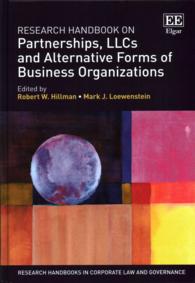- ホーム
- > 洋書
- > 英文書
- > Literary Criticism
Full Description
From action movies to video games to sports culture, modern masculinity is intrinsically associated with violent competition. This legacy has its roots in the 19th-century Romantic figure of the Byronic hero--the ideal Victorian male: devoted husband, sexual revolutionary and weaponized servant of the state. His silhouette can be traced through the works of authors like Lord Byron, Jane Austen, Sir Arthur Conan Doyle, Rudyard Kipling and Oscar Wilde.
More than a literary genealogy, this history of the Byronic hero and his heirs follows the changes that masculinity has undergone in response to industrial upheaval, the rise of the middle class and the demands of global competition, from the Victorian period through the early 20th century.
Contents
Table of Contents
Preface
Introduction
Part I. The Byronic Hero
in the Domestic Novel
One. A Home at Sea: Piracy in Lord Byron's The Corsair and Jane Austen's Persuasion
Two. A House Fit for a Lady: Lord Byron's Manfred and Emily Brontë's Wuthering Heights
Three. Bad Romancers: Domestic Enclosures in George Eliot's Middlemarch and H. Rider Haggard's She
Part II. The Rhetoric of Romance Masculinity
Four. A Secret History: The Byronic Hero in Charles Dickens's David Copperfield
Five. "Hey you, there!" Transforming Dickens's Domestic Masculinity into Romance Masculinity in Stevenson's Treasure Island
Six. Being Home: The Schizophrenic Enclosure as Dr. Jekyll and Dorian Gray
Seven. Writing the Rebel into Shape: Schizophrenia as Form in Sir Arthur Conan Doyle's Sign of Four and E.W. Hornung's Raffles Stories
Eight. The Double Agent: Romance Masculinity in Rudyard Kipling's Kim, Baden-Powell, and the Boy Scouts
Conclusion: Romance Masculinity and Contemporary Masculinity
Chapter Notes
Works Cited
Index


![Observations Sur Les Fosses D'aisance, [et] Moyens De Prévenir Les Inconvéniens De Leur Vuidange : Par Mm. Laborie, Cadet Le Jeune Et Parmentier ......](../images/goods/ar/work/imgdatag/12724/1272468062.JPG)





